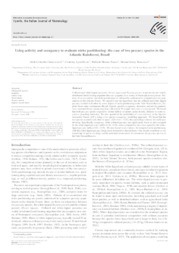Using activity and occupancy to evaluate niche partitioning: the case of two peccary species in the Atlantic Rainforest, Brazil.
Using activity and occupancy to evaluate niche partitioning: the case of two peccary species in the Atlantic Rainforest, Brazil.
Autoria: FERREGUETTI, A. C.; DAVIS, C. L.; TOMAS, W. M.; BERGALLO, H. G.
Resumo: Collared and white-lipped peccaries (Pecari tajacu and Tayassu pecari, respectively) are widely distributed, herd-forming ungulates that are sympatric in a variety of Neotropical ecosystems. Patterns of co-occurrence and niche partitioning are still poorly understood in sympatric peccary populations in the Atlantic Forest. We aimed to test the hypothesis that the collared and white-lipped peccary avoided each other by some degree of niche partitioning in the Vale Natural Reserve, Espírito Santo state, southeastern Brazil. Species-specific occupancy, detection, and activity patterns were estimated from camera-trap data collected at 39 sample sites over a 1-year period. We found that both peccary species respond to similar habitat covariates (palm density, distance to water resources, poaching intensity). We also quantified the probability of co-occurrence, or the Species Interaction Factor (SIF), using a two-species occupancy modelling approach. We found that the two species avoided each other in space (SIF=0.410.02), thus providing evidence for niche partitioning. Specifically, occupancy of the collared peccary was significantly lower at sites occupied by the white-lipped peccary (yBA=0.240.08) when compared to sites unoccupied by the whitelipped peccary (yBa=0.800.05). We also found weak evidence for temporal niche partitioning, with the white-lipped peccary being more restricted to diurnal hours. Our results contribute to our knowledge of species ecology and the potential mechanisms of coexistence for peccary species in the Vale Natural Reserve.
Ano de publicação: 2018
Tipo de publicação: Artigo de periódico
Unidade: Embrapa Pantanal
Observações
1 - Por padrão são exibidas publicações dos últimos 20 anos. Para encontrar publicações mais antigas, configure o filtro ano de publicação, colocando o ano a partir do qual você deseja encontrar publicações. O filtro está na coluna da esquerda na busca acima.
2 - Para ler algumas publicações da Embrapa (apenas as que estão em formato ePub), é necessário ter, no celular ou computador, um desses softwares gratuitos. Sistemas Android: Google Play Livros; IOS: iBooks; Windows e Linux: software Calibre.
Acesse outras publicações
Acesse a Base de Dados da Pesquisa Agropecuária (BDPA) para consultar o acervo completo das bibliotecas da Embrapa.

